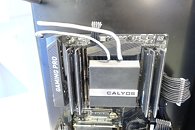Friday, June 2nd 2017
Calyos Showcases Its NSG S0 Phase Change Cooling Chassis at Computex 2017
Remember that Kickstarted case from Calyos, which promises to be the ending of spinning fans on your rig? Calyos is showcasing it at this year's Computex.
The production chassis is designed by France's modding duo WaterMod, which improved upon the original open-frame concept design both in terms of performance and aesthetics. The usage of Phase Change cooling through two cooling blocks - one for the GPU, another for the CPU) makes away with fans, pumps, water, and any other assorted cooling techniques that involve calling upon the decibel gods.
The production chassis is designed by France's modding duo WaterMod, which improved upon the original open-frame concept design both in terms of performance and aesthetics. The usage of Phase Change cooling through two cooling blocks - one for the GPU, another for the CPU) makes away with fans, pumps, water, and any other assorted cooling techniques that involve calling upon the decibel gods.





39 Comments on Calyos Showcases Its NSG S0 Phase Change Cooling Chassis at Computex 2017
Example of behavior that is not acceptable:
www.kickstarter.com/projects/1489140137/nsg-s0-worlds-first-fanless-chassis-for-high-perfo
I debated on this for awhile before i did so it ran me 650 bucks for a case plus shipping.
But I did so for a reason my current case sounds like a tornado tons of fans to keep it cool i pretty much have to have earbuds or a head set to stay sain.
If you dont like linus video theres also this
So how can i justify 675 for a case? I have been looking into getting a water cool setup for awhile now and a good setup would cost me around that. Plus its a uniq case that no one has and while I do have to spend more money on a silent power supply to make it silent this will cool just as well as a water cooling system with out the need for fans and it can be overclocked and if you really want to push overclocking yes you can add fans to it but I think the silence will keep me happy, also dont have to worry about water leaks, air bubbles or flushing the system.
Note no spot for a second GPU.
Small note on the silence there are no moving parts which is why its so quiet but there is still an electrical hum barely noticeable by the electrical components on the motherboard/power supply/gpu. But at 18dB and the fact that you can hear that is still very impressive.
If you OC, do please come back with some temp numbers once you're all set.
As originally stated, all i had was an impression, said it myself, don't know any better. Am perfectly willing to accept it will be suitable for normal situations, definitely need some numbers when we're talking OCing here.